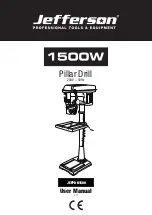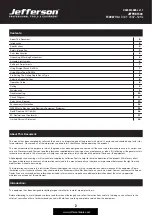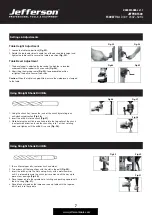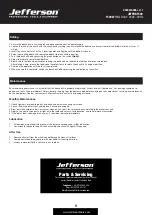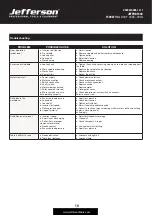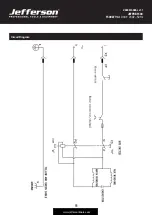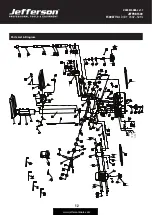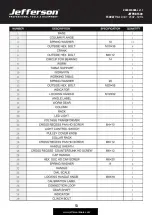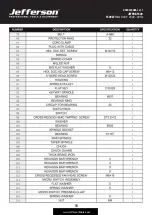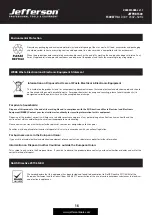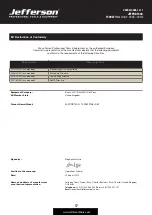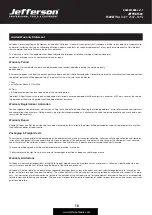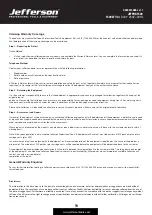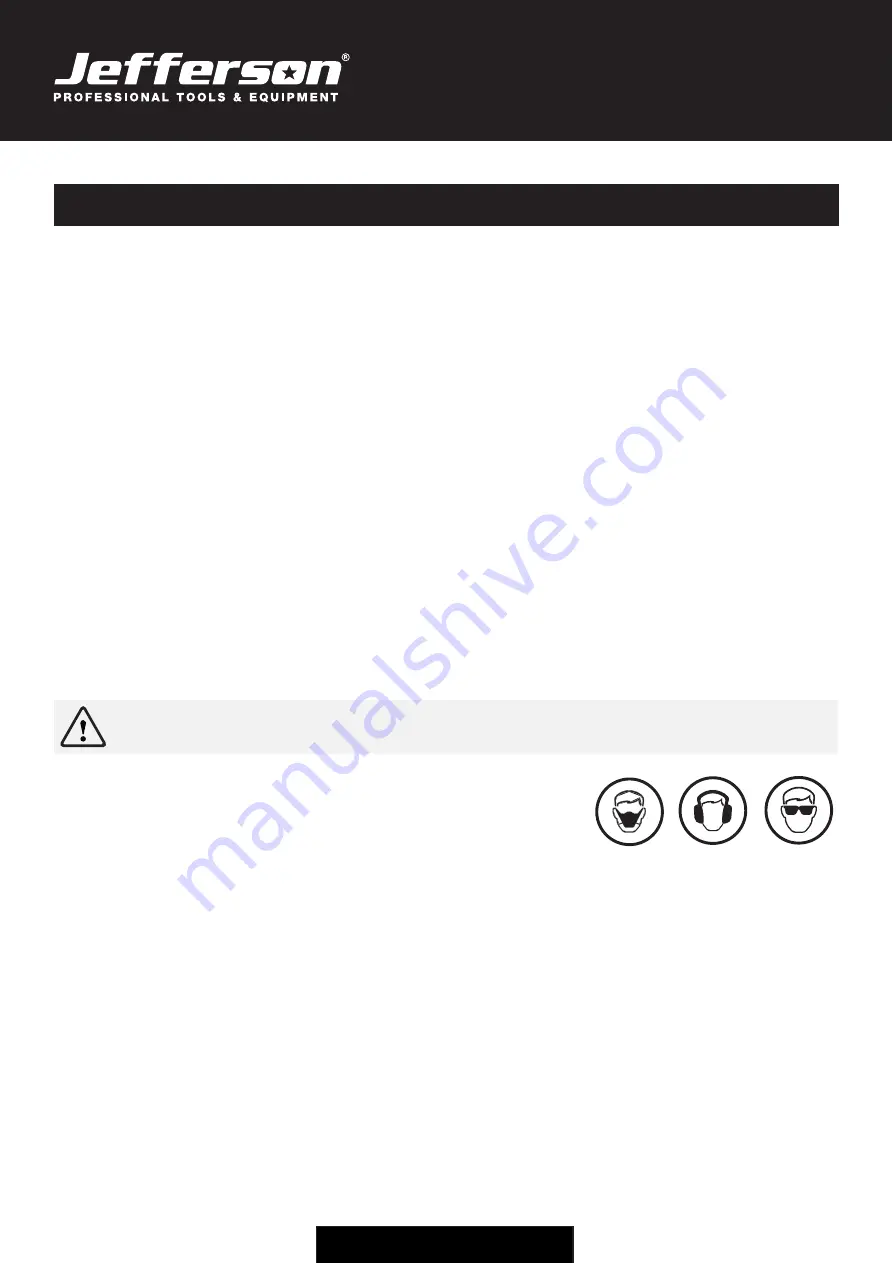
4
USER MANUAL v1.1
JEFPDB1500
1500W
Pillar Drill • 230V ~50Hz
www.jeffersontools.com
Safety Information: (continued)
Equipment Safety
•
Always keep guards in place and in clean, working order. A guard or other part that is damaged should be properly repaired or replaced using
Jefferson approved parts.
•
Don’t force the machine or use it for purposes other than it was designed for. Do not modify the equipment to improve performance or ex-
ceed the specified rated speed.
•
Remove any adjusting keys or wrenches before using the equipment.
•
Always disconnect the machine from the power supply before carrying out any servicing or changing accessories.
•
Check the alignment and condition of all moving parts before use. Do not use if any parts are damaged or worn.
•
Never remove the cover panel unless the machine is disconnected from the power supply, and never use the machine with the cover panels
removed.
•
Guard against electric shock. Avoid body contact with earthed or grounded surfaces.
•
This equipment is designed for use in dry, indoor working environments with suitable ventillation.
•
Avoid accidental starting by making sure the power switch is off before plugging in the power cable.
•
Never operate the machine until it is completely assembled and you have read and understood this entire manual.
•
Always use clamps or a drill vice bolted to the table, to hold the work. The workpiece should never be held with bare hands.
•
Always shut off the power & remove the drill bit before leaving the machine. Never leave the drill unattended whilst it is running.
•
Always use the correct drilling speeds for the drill size and the type of material being drilled.
•
Always remove and store the drill bits when you have finished working with the equipment.
•
Never attempt to drill into a workpiece that does not have a flat surface unless a suitable support is used.
•
Always stop the drill before removing workpieces, work supports or swarf from the table.
•
Keep drills sharp and clean for best and safest performance.
•
Adjust the table or depth stop where necessary to avoid drilling into the table surface.
•
Always be sure that the drill bit is securely locked in the chuck.
•
Never assemble or set up any work on the table while the drill is running.
•
Always ensure the table lock is tight before starting the drill.
•
Keep the handles dry, clean and free from oil and grease.
•
Always keep hands and fingers away from the drill bit when the equipment is connected to the power supply.
•
Do not operate the equipment if you are tired or under the influence of alcohol, drugs or medicine.
•
Keep children and animals away from the equipment and work area at all times.
Dust generated from certain materials can be hazardous to your health. Always operate the drill in a well-ventilated area. Use a dust
collection system if possible. Use a dust mask or other suitable respiratory protection as required. The use of any accessory or
attachment other than one recommended in this instruction manual may present a risk of personal injury.
Protective Clothing
•
Always wear the appropriate clothing and personal protection equipment
•
Non-slip footwear and safety boots is recommended.
•
Wear a protective hair covering or tie back long hair.
•
Always wear safety glasses and ear protection.
•
Wear a face mask if drilling into any material which produces dust.
•
Do not operate this equipment using loose clothing or other jewellery may get caught in moving parts.
Electrical Safety
•
Ensure that you check the equipment thoroughly to ensure it is safe and fit for purpose before each use. It is important that you inspect all
plugs, sockets, power cables and electrical fittings for wear and damage and repair or replace any defective components. The risk of electric
shock can be minimised by the correct use of the appropriate electrical safety devices.
•
We recommend that you fit a
Residual Current Circuit Breaker (RCCB)
in the main distribution board and that a
Residual Current Device
(RCD)
is used when operating this equipment.
•
The
Electricity at Work Act 1989
includes legislation that places legal implications on employers to ensure the safety of electrical devices
in the workplace. The regulations dictate that all portable equipment must be inspected regularly and tested to ensure that it is safe for use.
'Portable equipment' means any electrical item that can be moved and this is often referred to as
Portable Appliance Testing (PAT)
. PAT
testing should be carried out regularly on this equipment by trained, authorised personnel, as required by the legislation.
The
Health and Safety at Work Act 1974
states that it is the responsibility of the owner of electrical appliances to ensure that both the
equipment and working environments are maintained to ensure safe operation at all times.
•
Check that all equipment cables are secure, correctly insulated, free from damage, and protected against short circuit and overload before
connecting to the power supply. Do not use worn or damaged cables, plugs, sockets or other fittings.
•
Ensure that the power supply matches voltage requirements specified on the equipment and that the plug is wired correctly and fitted with
the correct fuse. If the electrical fuse blows, ensure it is replaced by an identical type of fuse with the same rating. maintaining, cleaning,
replacing or checking any parts.
•
Ensure the power cable is kept away from heat, oil and sharp edges.
•
Always disconnect the equipment from the power source before servicing, inspecting, adjusting or changing accessories.
Summary of Contents for JEFPDB1500
Page 1: ...User Manual v 1 1 JEFPDB1500 Pillar Drill 230V 50Hz...
Page 13: ...13 USER MANUAL v1 1 JEFPDB1500 1500W Pillar Drill 230V 50Hz www jeffersontools com...
Page 14: ...14 USER MANUAL v1 1 JEFPDB1500 1500W Pillar Drill 230V 50Hz www jeffersontools com...
Page 15: ...15 USER MANUAL v1 1 JEFPDB1500 1500W Pillar Drill 230V 50Hz www jeffersontools com...

